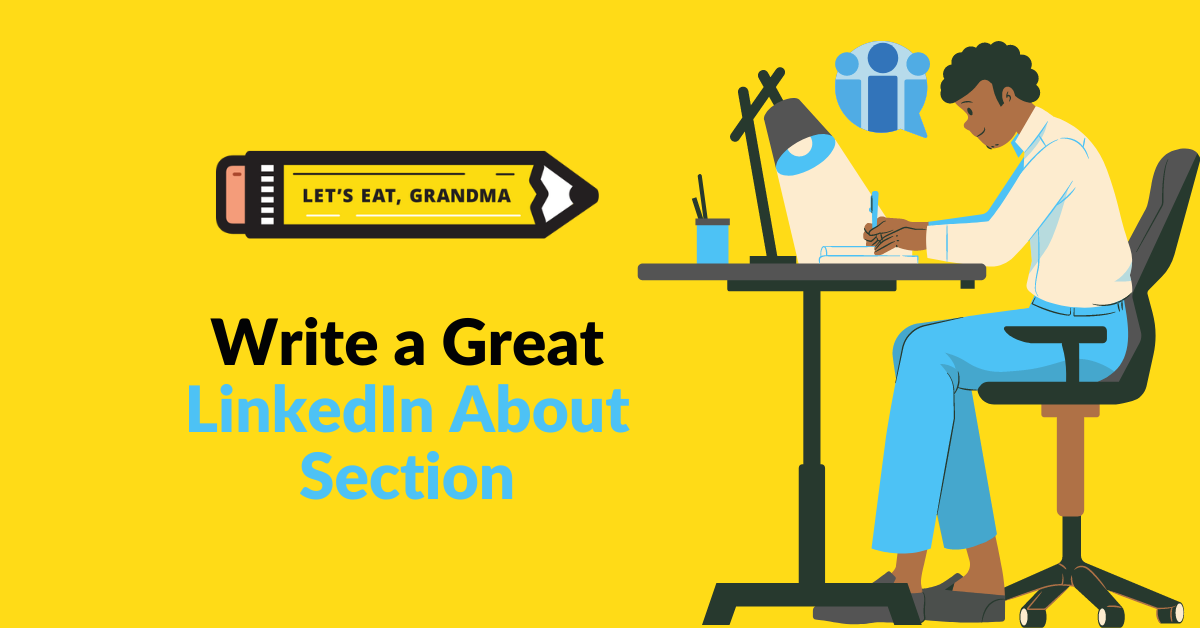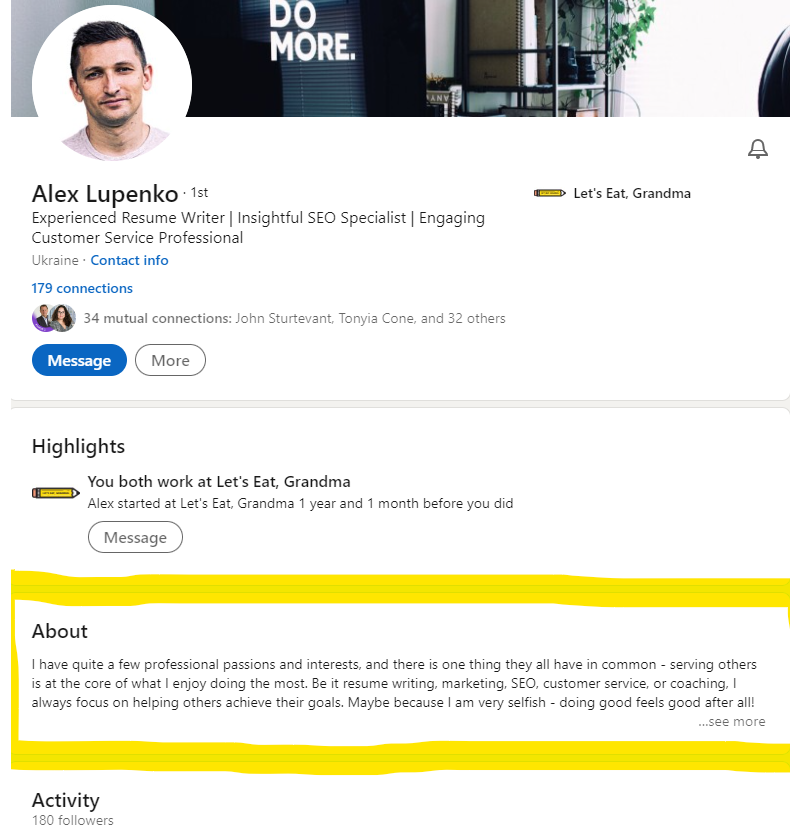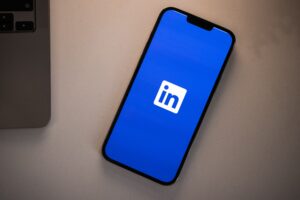How to Write a Great LinkedIn About Section/Summary Section (with Examples)

Most people don’t make the most of their LinkedIn profile. The About section, formerly known as the Summary section, is especially overlooked as a place to zhuzh up your professional online presence with personality and details. Read on for tips and examples for a great LinkedIn About section.
Editor’s note: This post was originally published in 2022; it has been updated for accuracy and comprehensiveness.
By: Tonyia Cone | Contributor for Let’s Eat, Grandma
With more than 67 million companies listed and six people hired every minute on the platform, LinkedIn is an important tool in your job search.
Your LinkedIn About section (formerly called the Summary section), is especially important.
Unlike your professional documents and the rest of your professional digital presence, it gives you space where you can let your character shine.
You need to keep in mind that while your tone here doesn’t need to be formal, you are writing this for a professional purpose. This is probably not the right place to post that story about the time you won the keg stand contest last month.
However, it is a chance to write some of your personality into your professional introduction, giving you an opportunity to stand out from the competition in a memorable way.
Ready for more job search help?
Sign up for a free Senior Writer Resume Critique to see what's holding you back from landing interviews. One of our top professional resume writers will give you personalized feedback on the top 3 items you can improve based on our expert practices!
What is the LinkedIn About section?

The About section is one of the first things a recruiter sees on your LinkedIn profile.
The LinkedIn About section is the space found at the top of your profile with the title “About.” It’s one of the first things a viewer sees on your profile.
When you click on the edit icon, found on the right side of the section (it looks like a pencil), a new box opens that says,
You can write about your years of experience, industry, or skills. People also talk about their achievements or previous job experiences.
But the LinkedIn About section should be more than a simple overview of your experience or a repeat of the information in your cover letter or resume.
In fact, many job seekers make the mistake of copying a few sentences from their cover letter or resume to give a general description of the kind of work they do.
This approach leaves on the table the strengths that make LinkedIn different from old-school professional documents.
As LinkedIn is a digital tool, users are not limited by space in the way they are in a cover letter and resume. You have a full 2,600 characters to use in the About section. While the entire section is not visible to every viewer, they’re free to click “read more” and scroll through as they wish.
In addition, LinkedIn is a social media platform, so you can be a bit more casual here than in your cover letter and resume. Use the About section to point out the things that make you the best choice for the kind of job you want and keywords that will match your strengths and experience with the positions you want to be recruiter for.
Some of the information you include in your LinkedIn About section might not be a good fit for your resume, but a key advantage of LinkedIn is the fact that it is not your resume. So use the platform to complement your professional documents with information you may have had to omit from them, as well as details that humanize you as a candidate.
Why is the LinkedIn About section important?

LinkedIn is a more informal tool for an employer to learn more about candidates. Photo by dlxmedia.hu on Unsplash
LinkedIn is not only a place to build your professional network — recruiters and hiring managers have been increasingly use it as a hiring tool. While other sections on your profile, like your Skills section, have highly defined parameters, the About section is an open text space. This makes it one of the easiest sections to add keywords to appear in recruiter searches as a job candidate.
With fewer restrictions than other LinkedIn sections, the About section gives you an opportunity to describe your major strengths and achievements to show anyone who is hiring (or knows someone who is) why you’re the perfect fit for the job you want.
The section also gives you a space to clarify things (like a desire to relocate) that may not be clear about your job search, and address potential red flags you may be nervous about.
Example: If you are worried a career gap may reflect poorly on your progression, use this space to spin the time off to show how you enriched yourself.
Say you are a CPA who took time off work during the pandemic to care for an aging parent. Go ahead and talk about that here. Just don’t forget to mention all the skills you learned or strengthened in that time that you could now pivot to a new specialty in elder planning.
Better yet, if you took the initiative to take online courses, earn new certifications, volunteer, or develop an interesting hobby, discuss those enriching experiences here.
How to write a great LinkedIn About section

Linkedin gives you a forum to show your passion and interests. Photo by Daniel Thomas on Unsplash
Your LinkedIn About section is a great place to tell your career story, highlight your strengths, discuss what you are proud of, and explain what you enjoy about your work to show your passion in a way that your resume can’t.
Another way to think of this is the CliffsNotes of your career experience, with an emphasis on the things that make you most marketable, memorable, and a strong candidate for the job you want (not necessarily the job you have).
First of all, it’s important to kick your About section off with a catchy opening. Keep it interesting enough for a recruiter or hiring manager to want to keep reading. Use a personal, informal tone, but be sure to match your industry.
Alex Lupenko at Let’s Eat, Grandma does a great job of all this in his LinkedIn summary:
I have quite a few professional passions and interests, and there is one thing they all have in common – serving others is at the core of what I enjoy doing the most. Be it resume writing, marketing, SEO, customer service, or coaching, I always focus on helping others achieve their goals. Maybe because I am very selfish – doing good feels good after all!
Alex has a lot of personality in his first paragraph. He tells us about the type of work he does while telling us about his strengths in an interesting way, using a casual and appropriate tone.
While telling your story, it’s good to highlight your accomplishments along with the metrics and specific examples to back those up (just like on your resume). Along with that, your LinkedIn summary is also a great place to discuss things that are important to you, like your professional values.
Chris Villanueva, one of our co-founders here at Let’s Eat, Grandma, gives us a perfect example of this. In his LinkedIn About section, he explains:
Service is at the heart of my career and will be until the day I retire. I studied hospitality at Cornell University, and I spent my time at The Hotel School dedicated to best business practices in communication. As a professional, I strongly believe in integrating hospitality and top-notch customer service into every aspect of business. I work hard to make job seekers feel cared for and exceed customer expectations. And I work hard to instill more confidence in their job search.
After reading only one paragraph about Chris, I get a strong sense of what he does as well as what drives him as a professional. He seems like a pretty great guy who would be great to work with!
Another approach is to structure your paragraphs with three key skills related to your current target role. Again, this should be forward looking at what you have to offer the job you want, not just focused on describing the job you already have. This is another point Alex really nails in his LinkedIn summary:
RESUME WRITING: Having written over 1000 resumes, I am experienced in all aspects of creating targeted, ATS-friendly resumes that help job seekers land interviews…
SEARCH ENGINE OPTIMIZATION: Attracting traffic and boosting website rankings in the search engines is another passion of mine. I like fine-tuning websites by researching keywords, developing effective content strategies, building links, and discovering new partnership opportunities to drive organic traffic. Interestingly enough, this skill helps me a great deal when writing resumes! Using specific keywords, tailoring content, and utilizing various engagement strategies – these techniques from the SEO playbook can catapult any resume to the top of the heap!
CUSTOMER SERVICE: With a strong background in providing direct customer service and solid experience in helping with marketing programs, I am capable of grasping customer needs quickly and converting the company’s services into desirable client solutions…
I really like how he connects his past work with SEO to resume writing. That’s a pretty slick strategy.
Like your cover letter, the next step in your summary is to include a call to action. You want people to take action with your profile, not just glance over it, right? Ask the person reading your About section to contact you for an interview or to learn more, check out your portfolio, or recommend connections.
Let’s Eat, Grandma’s other co-founder, Matt Villanueva gives us two fantastic examples of a call to action:
If you’d like to learn more about me or how we can get connected, please email me at [email protected].
If you’d like to find out how we can help you with your professional writing needs, please don’t hesitate to email our team at [email protected] or visit www.letseatgrandma.com. And If you want to join a serious company of writers and support team that actually make a difference, let us know here or at https://www.letseatgrandma.com/careers/
He asks his readers to connect with him as an individual and plugs his company. That’s a great way to make the most of the opportunity to promote himself and his business. Like Matt, don’t forget to include your email address so readers know how to reach you.
One last important and pretty easy way to build keywords into your profile and highlight skills from your resume (especially if you want to include them but don’t know where to include them) is by using blocks of keywords and position titles at the end of your summary section.
My own LinkedIn About section could always use improvement, but this is one thing I got right. At the end of my summary section, I include this list:
Specialties: Digital Communications | Digital and Print Writing and Editing | Blogging | Interviewing | Content Management | Content Creation | Profiles | Features | Medical Writing | Real Estate Writing | Tech Writing | Business Writing | Cannabis Industry Writing | Resume Writing | Cover Letter Writing
I ran out of time when I realized I really needed to improve my summary section, but this was a quick fix I could do because it’s the skills and expertise section that I cut and pasted from my resume. Feel free to do the same!
Make the most of it!
This may seem like a lot to fit into a small space, but fortunately, unlike your resume, it’s not as important to keep your LinkedIn About section short.
LinkedIn gives you 2,600 characters in this summary section. Don’t be afraid to use as many of those as you need to make the most of this opportunity to humanize yourself and round out the rest of your professional documents and online presence.
Ready for more job search help?
Sign up for a free Senior Writer Resume Critique to see what’s holding you back from landing interviews. One of our top professional resume writers will give you personalized feedback on the top 3 items you can improve based on our expert practices!
